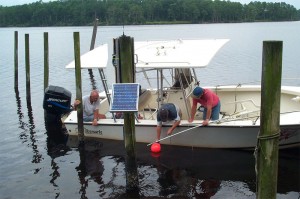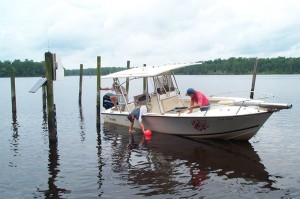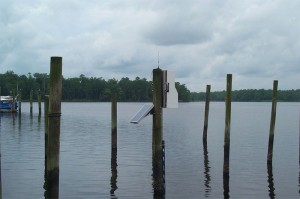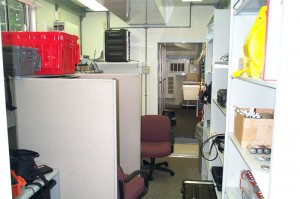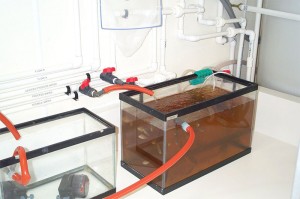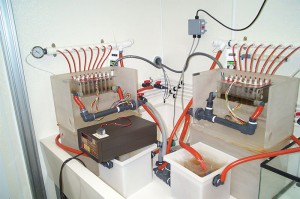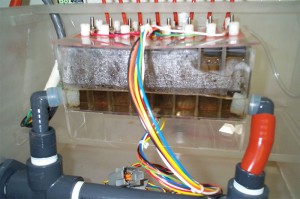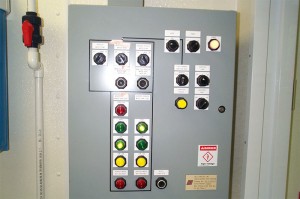Legacy Fish Biomonitoring Project
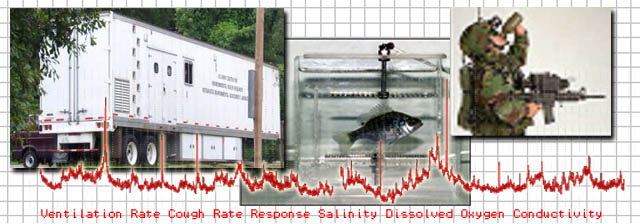 The Legacy Project is a joint effort between the United States Army Center for Environmental Health Research (USACEHR), the NCSU Center for Applied Aquatic Ecology, and funded by the U.S. Department of Defense Legacy Project. In this project we are designing and testing a prototype automated biomonitor for early warning of toxic hazards in aquatic ecosystems.
The Legacy Project is a joint effort between the United States Army Center for Environmental Health Research (USACEHR), the NCSU Center for Applied Aquatic Ecology, and funded by the U.S. Department of Defense Legacy Project. In this project we are designing and testing a prototype automated biomonitor for early warning of toxic hazards in aquatic ecosystems.
Monitoring of aquatic ecosystem health is a difficult undertaking. Many existing environmental monitoring systems are directed at detecting specific pollutants. The problem with this chemical-by-chemical approach is that unexpected pollutants can go undetected, and pollutant mixtures can cause harmful effects even when individual chemicals are at “safe” levels. As a solution, this “fish as sentinels” live-organism-based, automated biomonitoring system will respond to a broad spectrum of contaminants. The biomonitor will enable evaluation of changing water quality conditions, using fish physiological responses. Computer monitored endpoints include fish behavior (ventilatory rate and depth, cough rate, and movement) plus water quality parameters (dissolved oxygen, pH, temperature, conductivity/salinity, redox, and water level). The system is being automated for capability in alerting authorities about pollutant spills.
Once the prototype design and testing is completed, additional biomonitoring systems will be constructed for strategic placement to provide unique continuous, real-time fish behavioral toxicity data for tracking contaminant dispersal. The prototype is being developed and tested in the Neuse River Estuary, NC, a major estuarine system that is prone to oxygen deficits, pollutant spills, harmful algal blooms, and fish kills. This proof of concept project will serve as a foundation for developing improved regional watershed monitoring programs applicable in other watersheds where there are concerns for toxicity-related events.
Project Photo Gallery
- Installation of water column prolifer at Pelican Point. Buoy keeps water probe at a consistent depth of 1 meter.
- Deployment of Pelican Point water intake. Intake is near water probe, so inital water quality measurements can be taken.
- The finished profiler box, which houses the electronic conrtoller and datalogger, mounted on a pylon near intake point.
- USACEHR mobile laboratory, which houses the Legacy project equipment.
- Inside the mobile lab is a fully equipped water quality monitoring station. Water from the creek flows into here for further evaluation using fish bioelectricity.
- Holding tank with water directly from the creek for fish that will be used in the bioelectric measuring chambers.
- Bioelectric measuring chambers monitor fish response to changes in conditions of the water flowing through the chambers. Water is supplied from the creek.
- Second chamber is used to acclimate fish before being introduced into the chamber.
- Close up of chambers. Electrodes on the top and bottom detect passive voltage differences from the fish’s reactions.
- Programmable Logic Controller (PLC)- Controls all systems, and sets alarms for various conditions.

